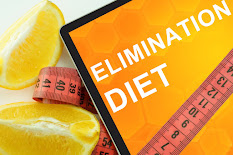 Lets consider a situation where you receive a consultation for a client that has been experiencing GI symptoms when on a normal diet. The physician is concerned that it may be a food intolerance, allergy, or other inflammation-related health condition.
Lets consider a situation where you receive a consultation for a client that has been experiencing GI symptoms when on a normal diet. The physician is concerned that it may be a food intolerance, allergy, or other inflammation-related health condition.
The Basic Elimination Diet Protocol is one method of determining which foods are leading to the GI discomfort. There are the two phases...the elimination phase and the re-introduction phase.
I received a question from dietitians in Sweden about what the PES statements might be for these two different phases.
PHASE ONE:
For the first stage where most products are eliminated to eliminate the adverse GI signs and symptoms, the PES statement might be as follows:
Intake of protein inconsistent with needs
related to allergy or malabsorption syndrome from unknown protein substance
as evidenced by medical diagnosis of potential food allergy/malabsorption and symptoms of diarrhea, nausea, vomiting when consuming normal diet.
PHASE TWO:
However after the foods have been eliminated from the diet, signs and symptoms of GI distress are no longer present. You are now entering the testing in the re-introduction phase. The PES statement might be:
Altered GI Function
related to allergy or malabsorption syndrome from unknown protein substance
as evidenced by medical diagnosis of potential food allergy/malabsorption and symptoms of diarrhea, nasuea, vomiting when consuming normal diet.
In this case we assumed that the substance was a protein, however it could be a carbohydrate, such as in the FODMAP Diet (e.g. short chain carbohydrates). In some circles a variation of this is called the Autoimmune Protocol Diet.
In this discussion we also assumed that the signs and symptoms would be GI disturbances. However, in some cases, the Basic Elimination Diet may also be used to test whether there are food allergies or intolerances related to atopic dermatitis or eczema signs and symptoms. This science in this area is less clear, however some believe that there may be some intrinsic skin defect (in this case in the GI tract) that allows allergens to enter the skin and results in an allergic/autoimmune response. One way to verify that there might be a connection between food consumption and skin disruptions for an individual patient is using the Basic Elimination Diet Protocol/Autoimmune Protocol.
While the current reference sheet included in eNCPT for Altered GI Function only includes GI symptoms, it does include reference to abnormal antibodies as one of the signs and symptoms. It also includes Celiac Disease as one of the medical conditions that might be documentation of altered GI function.
Whether this term, Altered GI Function, can also be used to describe altered GI functions that are thought to be associated with symptoms for dermatitis could be submitted to the Academy for consideration of whether this is an appropriate use of the term. If so, the question might also ask whether the reference sheet should be expanded to clearly indicate the appropriateness of this use of the term in this type of situation.
Academy
of Nutrition and Dietetics. Nutrition Terminology Reference Manual (eNCPT):
Dietetics Language for Nutrition Care. Intake
of Types of Proteins Inconsistent with Needs (Specify) (NI-5.6.3), Reference
Sheet. Available at: https://www.ncpro.org/pubs/encpt-en/codeNI-5-6-3.
Accessed November 19, 2020
Academy
of Nutrition and Dietetics. Nutrition Terminology Reference Manual (eNCPT):
Dietetics Language for Nutrition Care.
Intake of Types of Carbohydrates Inconsistent with Needs (Specify)
(NI-5.8.3), Reference Sheet. Available at: https://www.ncpro.org/pubs/encpt-en/codeNI-5-8-3.
Accessed November 19, 2020
Academy of
Nutrition and Dietetics. Nutrition Terminology Reference Manual (eNCPT):
Dietetics Language for Nutrition Care.
Altered Gastrointestinal (GI) Function (NC-1.4), Reference Sheet.
Available at: https://www.ncpro.org/pubs/encpt-en/codeNC-1-4.
Accessed November 19, 2020.

